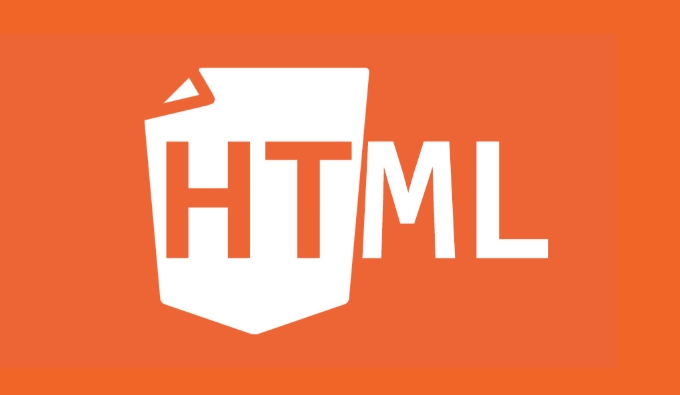To beautify the horizontal lines in the web page, you need to customize the style. The specific methods are as follows: 1. Adjust the color, thickness and width to change the basic appearance; 2. Improve the design sense through dotted lines, gradients or adding icons; 3. Set the alignment and spacing reasonably to ensure the layout is coordinated. Use CSS to remove the default style and redefine the border, background-color, height, and width properties, such as setting hr {border: none; background-color: #ff4400; height: 2px; width: 80%;}. Further, visual embellishment can be achieved through pseudo-element addition icons such as hr::before, and at the same time, using margin and flex layout to control position and white space, ultimately making the horizontal line more in line with the overall style and practical and beautiful.

Adding a horizontal line is quite common in web pages, such as separating different sections or highlighting content structure. But the default<hr> The style is too monotonous. If you want it to look better and fit the overall style, you have to change the style yourself.
 ) in HTML?" /><hr>
) in HTML?" /><hr>
Basic style: start with color and thickness
<hr> The label itself has a default style, usually gray lines, with a width of 100% and a height of 1px. You can use CSS to adjust these properties:
 ) in HTML?" />
) in HTML?" />-
border: controls borders, removes the default borders and resets them -
background-color: Set the color of the line -
height: Adjust the height of the line, such as 2px or 3px, it looks more obvious -
width: can limit the length, for example, only 80% of the width
hr {
border: none;
background-color: #ff4400;
height: 2px;
width: 80%;
}This will turn the originally gray lines into the color you want, and it is more suitable for matching with different page themes.
Dotted design sense: dotted lines, gradients, icons
If you want the horizontal line to be more visually attractive, try these ways:
 ) in HTML?" />
) in HTML?" />Use the dotted line effect:
hr { border: 1px dashed #333; }Gradient lines (with background):
hr { height: 5px; background: linear-gradient(to right, #ff4400, #00aaff); border: none; }Add a small icon or text in the middle (using pseudo-element):
hr { position: relative; } hr::before { content: "?"; position: absolute; top: -10px; left: 50%; transform: translateX(-50%); background: white; /* block the lower lines*/ padding: 0 10px; }
These tips can make your dividing line less "ordinary" and better guide the user's sight.
Alignment and spacing: Don't ignore layout details
In addition to appearance, location is also important:
- Want to center the line? You can use
margin: autoor flex layout - It is recommended to use
margin-topandmargin-bottomto avoid squeezing with other content. - If you use pseudo-elements and icons, remember to adjust
topand background colors appropriately, otherwise it will be blocked by other elements.
hr {
margin: 40px auto;
text-align: center;
}These small details are not done well, and even the style is fancy, it will look messy.
<hr> Basically these are the methods. Revise<hr> The style of the label is not complicated. The key is to adjust the color, shape and layout according to the overall page style. Some places may require several debugging to align or coordinate color matching, but as long as you master the basic routine, you can easily make beautiful and practical horizontal dividing lines.
The above is the detailed content of How to style a horizontal rule () in HTML?. For more information, please follow other related articles on the PHP Chinese website!

Hot AI Tools

Undress AI Tool
Undress images for free

Undresser.AI Undress
AI-powered app for creating realistic nude photos

AI Clothes Remover
Online AI tool for removing clothes from photos.

Clothoff.io
AI clothes remover

Video Face Swap
Swap faces in any video effortlessly with our completely free AI face swap tool!

Hot Article

Hot Tools

Notepad++7.3.1
Easy-to-use and free code editor

SublimeText3 Chinese version
Chinese version, very easy to use

Zend Studio 13.0.1
Powerful PHP integrated development environment

Dreamweaver CS6
Visual web development tools

SublimeText3 Mac version
God-level code editing software (SublimeText3)

Hot Topics
 How do I stay up-to-date with the latest HTML standards and best practices?
Jun 20, 2025 am 08:33 AM
How do I stay up-to-date with the latest HTML standards and best practices?
Jun 20, 2025 am 08:33 AM
The key to keep up with HTML standards and best practices is to do it intentionally rather than follow it blindly. First, follow the summary or update logs of official sources such as WHATWG and W3C, understand new tags (such as) and attributes, and use them as references to solve difficult problems; second, subscribe to trusted web development newsletters and blogs, spend 10-15 minutes a week to browse updates, focus on actual use cases rather than just collecting articles; second, use developer tools and linters such as HTMLHint to optimize the code structure through instant feedback; finally, interact with the developer community, share experiences and learn other people's practical skills, so as to continuously improve HTML skills.
 How do I use the element to represent the main content of a document?
Jun 19, 2025 pm 11:09 PM
How do I use the element to represent the main content of a document?
Jun 19, 2025 pm 11:09 PM
The reason for using tags is to improve the semantic structure and accessibility of web pages, make it easier for screen readers and search engines to understand page content, and allow users to quickly jump to core content. Here are the key points: 1. Each page should contain only one element; 2. It should not include content that is repeated across pages (such as sidebars or footers); 3. It can be used in conjunction with ARIA properties to enhance accessibility. Usually located after and before, it is used to wrap unique page content, such as articles, forms or product details, and should be avoided in, or in; to improve accessibility, aria-labeledby or aria-label can be used to clearly identify parts.
 How do I create a basic HTML document?
Jun 19, 2025 pm 11:01 PM
How do I create a basic HTML document?
Jun 19, 2025 pm 11:01 PM
To create a basic HTML document, you first need to understand its basic structure and write code in a standard format. 1. Use the declaration document type at the beginning; 2. Use the tag to wrap the entire content; 3. Include and two main parts in it, which are used to store metadata such as titles, style sheet links, etc., and include user-visible content such as titles, paragraphs, pictures and links; 4. Save the file in .html format and open the viewing effect in the browser; 5. Then you can gradually add more elements to enrich the page content. Follow these steps to quickly build a basic web page.
 How do I create checkboxes in HTML using the element?
Jun 19, 2025 pm 11:41 PM
How do I create checkboxes in HTML using the element?
Jun 19, 2025 pm 11:41 PM
To create an HTML checkbox, use the type attribute to set the element of the checkbox. 1. The basic structure includes id, name and label tags to ensure that clicking text can switch options; 2. Multiple related check boxes should use the same name but different values, and wrap them with fieldset to improve accessibility; 3. Hide native controls when customizing styles and use CSS to design alternative elements while maintaining the complete functions; 4. Ensure availability, pair labels, support keyboard navigation, and avoid relying on only visual prompts. The above steps can help developers correctly implement checkbox components that have both functional and aesthetics.
 How do I minimize the size of HTML files?
Jun 24, 2025 am 12:53 AM
How do I minimize the size of HTML files?
Jun 24, 2025 am 12:53 AM
To reduce the size of HTML files, you need to clean up redundant code, compress content, and optimize structure. 1. Delete unused tags, comments and extra blanks to reduce volume; 2. Move inline CSS and JavaScript to external files and merge multiple scripts or style blocks; 3. Simplify label syntax without affecting parsing, such as omitting optional closed tags or using short attributes; 4. After cleaning, enable server-side compression technologies such as Gzip or Brotli to further reduce the transmission volume. These steps can significantly improve page loading performance without sacrificing functionality.
 How do I use the element to represent the footer of a document or section?
Jun 25, 2025 am 12:57 AM
How do I use the element to represent the footer of a document or section?
Jun 25, 2025 am 12:57 AM
It is a semantic tag used in HTML5 to define the bottom of the page or content block, usually including copyright information, contact information or navigation links; it can be placed at the bottom of the page or nested in, etc. tags as the end of the block; when using it, you should pay attention to avoid repeated abuse and irrelevant content.
 How has HTML evolved over time, and what are the key milestones in its history?
Jun 24, 2025 am 12:54 AM
How has HTML evolved over time, and what are the key milestones in its history?
Jun 24, 2025 am 12:54 AM
HTMLhasevolvedsignificantlysinceitscreationtomeetthegrowingdemandsofwebdevelopersandusers.Initiallyasimplemarkuplanguageforsharingdocuments,ithasundergonemajorupdates,includingHTML2.0,whichintroducedforms;HTML3.x,whichaddedvisualenhancementsandlayout
 How do I embed video in HTML using the element?
Jun 20, 2025 am 10:09 AM
How do I embed video in HTML using the element?
Jun 20, 2025 am 10:09 AM
To embed videos in HTML, use tags and specify the video source and attributes. 1. Use src attributes or elements to define the video path and format; 2. Add basic attributes such as controls, width, height; 3. To be compatible with different browsers, you can list MP4, WebM, Ogg and other formats; 4. Use controls, autoplay, muted, loop, preload and other attributes to control the playback behavior; 5. Use CSS to realize responsive layout to ensure that it is adapted to different screens. Correct combination of structure and attributes can ensure good display and functional support of the video.






